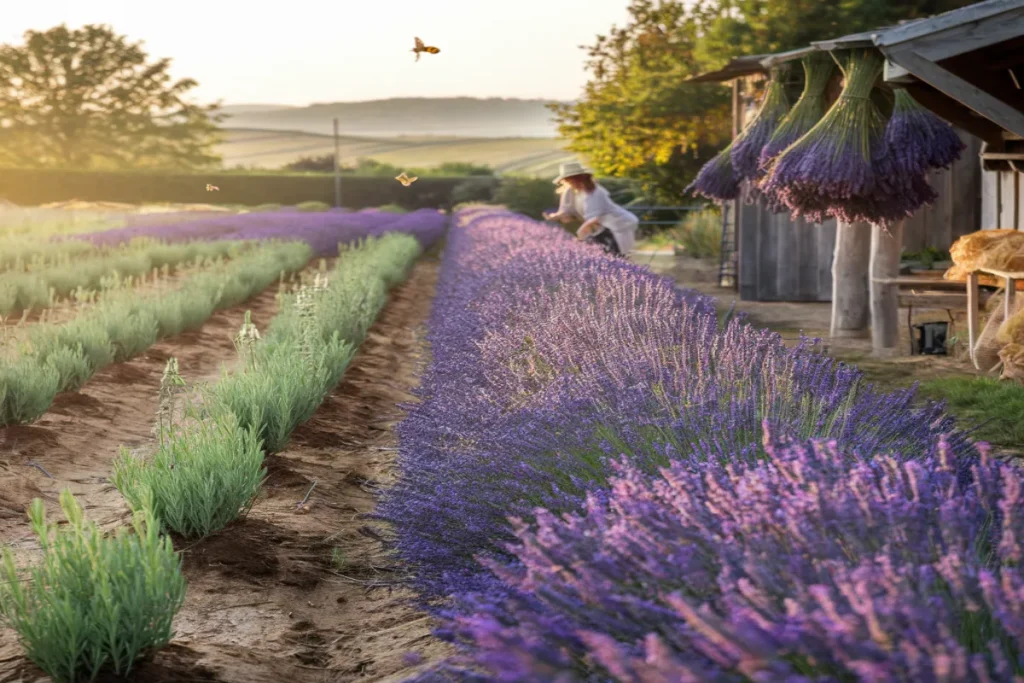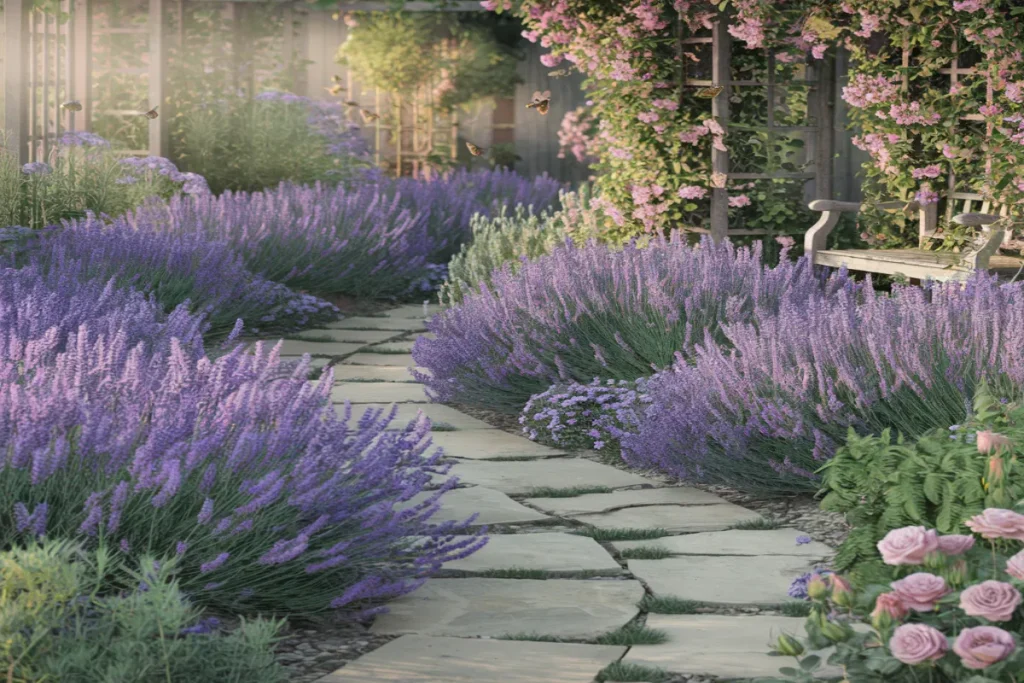Picture a serene summer afternoon in California’s Sonoma Valley, where rolling hills are draped in vibrant purple lavender fields. This picturesque scene captures the essence of lavender landscaping uses that have captivated gardeners for centuries. Lavender garden ideas transform ordinary outdoor spaces into extraordinary sensory experiences.
Gardens with lavender offer more than just visual beauty. Since late-medieval times, this versatile plant has been a staple in landscape design, adapting seamlessly to Mediterranean, cottage, and modern garden styles. The plant’s remarkable flexibility allows gardeners to create unique and enchanting landscapes that appeal to multiple senses.
Lavender‘s journey through landscaping history demonstrates its enduring charm. From medieval monastery gardens to contemporary urban designs, this aromatic herb has consistently proven its value. Gardeners appreciate its ability to thrive in USDA hardiness zones 5 to 9, making it accessible to a wide range of landscaping enthusiasts across different climates.
Landscape designers recognize lavender’s potential to create stunning visual compositions. Whether used in geometric patterns, rock gardens, or as border plantings, lavender provides structure, color, and fragrance. Its capacity to attract pollinators and its drought-tolerant nature make it an excellent choice for sustainable and eco-friendly garden designs.
As we explore the world of lavender landscaping, you’ll discover the numerous ways this remarkable plant can transform your outdoor spaces. From sensory gardens to modern minimalist designs, lavender offers endless possibilities for creative and functional landscaping.
Table of Contents
Benefits of Using Lavender in Landscaping
Lavender offers remarkable advantages for gardeners seeking both aesthetic and functional landscape solutions. Landscape uses of lavender plants extend far beyond simple ornamental beauty, providing multiple benefits that make this versatile herb a top choice for gardeners.
Aromatic Qualities of Lavender
The lavandula plant landscape use shines brightest through its extraordinary aromatic properties. Lavender releases a distinctive fragrance that transforms garden spaces into sensory experiences. Planting lavender near walkways or seating areas allows homeowners to enjoy its calming scent, which can reduce anxiety and promote relaxation.
- Provides natural aromatherapy in outdoor spaces
- Creates a soothing atmosphere
- Releases stress-reducing fragrance
Attracting Pollinators with Lavender
Is lavender good for privacy in landscaping? Absolutely! Beyond privacy, lavender serves as a critical ecosystem supporter by attracting beneficial pollinators. Its vibrant flowers act as magnets for bees, butterflies, and other essential insects crucial for garden health.
- Supports local bee populations
- Encourages butterfly migration
- Promotes overall garden biodiversity
Lavender’s Pest-Repelling Properties
Lavender stands out as a natural pest deterrent, offering protection for surrounding plants. Its strong scent effectively repels mosquitoes, fleas, moths, and ticks, making it an eco-friendly alternative to chemical repellents.
*Lavender: Nature’s own pest control solution*
Gardeners appreciate lavender’s multiple landscape benefits, from its beautiful appearance to its practical advantages in creating healthier, more vibrant garden ecosystems.
Popular Lavender Varieties for Landscaping
Lavender offers gardeners an incredible range of options for creating stunning landscape designs. With over 45 species and 450 unique varieties, selecting the right lavender can transform any outdoor space into a fragrant and visually appealing garden.
Gardeners seeking to use lavender as a ground cover or focal point will find multiple varieties suited to different landscaping needs. Each type brings unique characteristics that can enhance garden design and provide practical benefits.
English Lavender: Classic Garden Performer
English lavender (Lavandula angustifolia) stands out as a quintessential landscaping choice. Thriving in USDA zones 5-8, this variety reaches heights of 2-3 feet with impressive width spread of 2-4 feet. Its dense growth pattern makes it an excellent option for creating structured landscape elements.
- Blooms from late spring to early summer
- Strongly scented with deep purple flowers
- Ideal for edging and creating defined garden spaces
French Lavender: Unique Garden Accent
French lavender (Lavandula stoecha) provides a distinctive alternative for landscaping. With its feathery flower tufts and lighter pink-purple blooms, this variety adds visual interest to garden designs. Suitable for zones 7-10, it performs exceptionally well in warmer climates.
Spanish Lavender: Colorful Landscape Solution
Spanish lavender offers gardeners a drought-resistant and heat-tolerant option for landscaping. Flourishing in zones 8-10, this variety can withstand temperatures down to 15-20°F, making it perfect for challenging environmental conditions.
| Lavender Variety | USDA Zones | Height | Landscape Use |
|---|---|---|---|
| English Lavender | 5-8 | 2-3 feet | Edging, ground cover |
| French Lavender | 7-10 | 1-2 feet | Accent planting |
| Spanish Lavender | 8-10 | 1-3 feet | Drought-resistant areas |
When selecting lavender for landscaping, consider your specific climate, soil conditions, and design objectives. These versatile plants can serve as ground cover, create stunning focal points, and add sensory dimensions to any outdoor space.
*”The right lavender variety can transform a simple garden into a breathtaking landscape masterpiece.”*
Seasonal Lavender Landscaping Uses

Lavender transforms landscapes throughout the year, offering gardeners dynamic small lavender garden ideas that bring beauty and functionality to outdoor spaces. Understanding the seasonal rhythms of this versatile herb helps maximize its potential in landscaping design.
Spring Planting Strategies
Spring marks the ideal time for lavender planting ideas. Gardeners should focus on selecting well-draining locations with full sun exposure. When planning lavender in front of house areas, consider these essential planting tips:
- Choose sunny spots with minimal moisture retention
- Prepare soil with excellent drainage
- Space plants 12-18 inches apart for optimal growth
- Select varieties suited to your specific climate zone
Summer Maintenance Techniques
During summer, lavender reaches its peak blooming period. Proper maintenance ensures vibrant, healthy plants throughout the hottest months:
- Water sparingly to prevent root rot
- Prune after initial flowering to encourage compact growth
- Monitor for pest activity
Autumn Harvesting and Preservation
Late summer and early autumn provide perfect conditions for lavender harvesting. Collect flowers when they’re fully opened but before they begin to fade. Drying techniques can preserve lavender’s aromatic qualities for various uses:
| Harvesting Method | Preservation Technique |
|---|---|
| Cut stems in morning | Air dry in bunches |
| Use sharp pruning shears | Store in cool, dark place |
| Leave 2-3 inches of stem | Use in sachets, cooking, crafts |
*”Lavender’s seasonal journey transforms gardens from spring’s promise to autumn’s harvest.”*
With strategic planning, lavender can provide year-round value in landscape design, attracting pollinators and offering sensory delight through changing seasons.
Creating a Fragrance Garden with Lavender
Transforming your outdoor space into a sensory paradise begins with strategic lavender placement. A well-designed fragrance garden can transport you to a world of aromatic bliss, with lavender serving as the cornerstone of olfactory delight.
Companion Plants for a Scented Sanctuary
Creating a lavender walkway requires careful plant selection. Complementary aromatic companions can enhance the sensory experience of your garden. Consider these fragrant partners:
- Roses with vintage varieties for stronger scent
- Herbs like thyme and rosemary
- Jasmine for pollinator attraction
- Sage with its complementary herbal notes
Designing Your Lavender Flower Bed Ideas
Crafting lavender border ideas involves understanding plant characteristics and spacing. Lavender thrives in full sun, requiring at least 6 hours of direct sunlight daily. Space plants 2-3 feet apart to ensure proper air circulation and reduce mold risks.
| Lavender Variety | Height | Width | Fragrance Intensity |
|---|---|---|---|
| English Lavender | 1-2 feet | 1-2 feet | High |
| Provence Lavender | 3 feet | 3 feet | Medium-High |
| Hidcote Lavender | 1-2 feet | 1-2 feet | High |
Layout Strategies for Maximum Sensory Impact
When designing your fragrance garden, consider layering plants for depth and interest. Create gentle curves in your lavender walkway to guide visitors through the aromatic landscape. Incorporate varying lavender heights to add visual and olfactory complexity.
“A garden of fragrance is a living, breathing artwork that engages all senses” – Garden Design Experts
Remember that approximately 20% of gardeners prioritize aromatic plants. By implementing these lavender flower bed ideas, you’ll create a unique outdoor experience that delights and relaxes.

Lavender’s Role in Sustainable Landscaping
Sustainable landscaping has emerged as a critical approach for environmentally conscious gardeners. Lavender stands out as an exceptional plant for eco-friendly garden design, offering remarkable benefits for landscape uses of lavender plants.
Lavender provides unique advantages in garden design with lavender that support ecological balance and resource conservation. Its remarkable characteristics make it an ideal choice for sustainable landscaping practices.
Benefits of Native and Drought-Resistant Plants
Drought-tolerance is a key feature of lavender, making it an exceptional plant for water-conscious landscaping. Research demonstrates that lavender requires up to 60% less water compared to traditional landscaping plants, presenting significant environmental benefits.
- Supports biodiversity by attracting up to 30% more pollinator species
- Reduces water consumption in garden environments
- Thrives in various soil conditions with minimal intervention
- Naturally repels pests without chemical treatments
Eco-Friendly Practices with Lavender
Implementing lavender in landscaping can dramatically reduce maintenance costs and environmental impact. Studies indicate that sustainable landscaping practices using lavender can decrease maintenance expenses by 40% over time.
| Sustainable Benefit | Impact Percentage |
|---|---|
| Water Conservation | 60% Reduction |
| Pesticide Reduction | 50% Decrease |
| Pollinator Support | 30% Increase |
| Maintenance Cost Savings | 40% Decrease |
“Lavender represents not just a plant, but a sustainable solution for modern landscaping challenges.” – Environmental Gardening Expert
By integrating lavender into landscape design, gardeners can create beautiful, resilient, and environmentally responsible outdoor spaces that support ecological balance and reduce resource consumption.
Frequently Asked Questions
How do you use lavender in landscape?
Lavender is perfect for adding color, fragrance, and texture to your yard. Here are a few ways to use it:
🌿 Borders & Edging – Plant along walkways or garden beds for a soft, fragrant border.
🌿 Rock Gardens – Thrives in dry, well-drained soil alongside succulents and ornamental grasses.
🌿 Hedges – Use as a low hedge for a structured look.
🌿 Container Gardens – Perfect for patios, porches, or balconies.
🌿 Pollinator Gardens – Attracts bees, butterflies, and hummingbirds.
What are the downsides to growing lavender?
While lavender is beautiful and fragrant, there are a few drawbacks:
❌ Needs full sun – Struggles in shady areas.
❌ Hates wet soil – Root rot is a common issue.
❌ Takes time to establish – Can take a year or more to fully grow.
❌ Short bloom season – Usually flowers in summer but doesn’t bloom year-round.
❌ Not pet-safe for consumption – While not highly toxic, it can upset pets’ stomachs if eaten.
What should not be planted next to lavender?
Lavender prefers dry, well-drained soil, so avoid pairing it with plants that need moist or rich soil. Bad companions include:
❌ Mint & Basil – Need more water and can overtake lavender’s space.
❌ Hostas & Ferns – Prefer shade and damp conditions.
❌ Camellias & Azaleas – Thrive in acidic soil, while lavender prefers neutral to alkaline.
What does lavender do for your yard?
✅ Repels pests – Naturally deters mosquitoes, moths, and deer.
✅ Attracts pollinators – Bees and butterflies love it!
✅ Adds fragrance – Keeps your yard smelling amazing.
✅ Low maintenance – Once established, it needs little watering.
✅ Prevents soil erosion – Great for slopes or dry patches.
When not to use lavender?
🚫 If your yard is too shady – Lavender needs full sun (6-8 hours).
🚫 In waterlogged or clay soil – It hates wet feet.
🚫 If you need instant results – Lavender takes time to grow and won’t spread fast.
🚫 Near plants that need constant moisture – It prefers dry conditions.
Where is the best place to plant lavender in your yard?
A sunny, open spot – At least 6+ hours of direct sunlight.
Well-drained soil – A raised bed or sandy soil is ideal.
Near walkways, patios, or windows – So you can enjoy the fragrance.
On a slope or in a rock garden – Helps with drainage.
Tip: If your soil is heavy, mix in sand or gravel to improve drainage!

